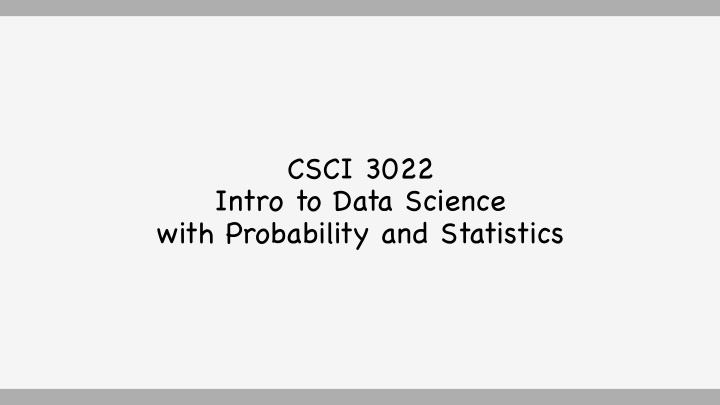



CSCI 3022 Intro to Data Science with Probability and Statistics
What is Data Science?
What is Data Science? Seriously. What do YOU think it is?
What is Data Science? Seriously. What do YOU think it is?
What is Data Science? Modeling and Machine Learning Data Analysis and Inferential Statistics Data Mining and Pattern Recognition
What is Data Science? Modeling and Machine Learning Data Analysis and Inferential Statistics Data Mining and Pattern Recognition Probability and Statistics Computing Tools Numerical Optimization Linear Algebra
Course Topics o Exploratory Data Analysis o Cleaning, Munging, and Wrangling Data o Probability Theory and Simulation o Hypothesis Testing and Inferential Statistics o Modeling and Classification
Exploratory Data Analysis Dig into your data, compute simple statistics, draw pictures and look for INSIGHT
Data Cleaning and Wrangling Some Data Scientists report they sped up to 80% of their time cleaning messy data sets
Probability Theory and Simulation Different probability distributions model different types of events
Probability Theory and Simulation Different probability distributions model different types of events The Binomial Distribution : The number of customers that will unsubscribe from your company’ s email-list as a function of how many advertisements you send them
Probability Theory and Simulation Different probability distributions model different types of events The Poisson Distribution : The number of online customers that will visit your website over a particular time period, or the daily number of car crashes on a particular stretch of road
Probability Theory and Simulation Different probability distributions model different types of events The Exponential Distribution : The amount of time you can expect a compute node in a large-scale cluster to function before failure
Hypothesis Testing and Inferential Statistics What is the data really telling us, and how confident should we be in our conclusions?
Hypothesis Testing and Inferential Statistics What is the data really telling us, and how confident should we be in our conclusions?
Hypothesis Testing and Inferential Statistics What is the data really telling us, and how confident should we be in our conclusions?
Hypothesis Testing and Inferential Statistics What is the data really telling us, and how confident should we be in our conclusions?
Modeling and Classification A gentle foray into Machine Learning. o Linear Regression o Multiple Linear Regression o Logistic Regression
The Plan Goal : Fluency in the theoretical and computational aspects of data analysis At the end of this course you’ll be able to 1. Clean, munge, and wrangle data in Python and perform Exploratory Data Analysis 2. Draw insight from data by computing and interpreting classic summary statistics 3. Know the ins-and-outs of probability and how to use it to solve real-world problems 4. Perform statistical tests to determine if your conclusions are real or due to chance 5. Construct and analyze simple models to make predictions and inferences about data 6. Tell compelling stories about data using modern visualization and presentation tools
Course Logistics Keep track of course webpages (Piazza and GitHub) o Piazza: https:/ /piazza.com/colorado/fall2017 /csci3022 Send me private messages on Piazza, rather than emails § Address message specifically to me if necessary § o GitHub: https:/ /github.com/chrisketelsen/csci3022 In-class work will be posted here, as well as homework § Good idea to clone repo and do a pull everyday before class § Good Git tutorial if you’re unfamiliar: http:/ /rogerdudler.github.io/git-guide/ §
Course Logistics Course Work : o Homework assignments every two weeks (35%) Lowest homework score dropped § 3 total late days (1min – 23hr 59min late = 1 late day) § o Class Participation through tutorial problems and short Moodle Quizzes (5%) o Midterm Exam (20%) o Practicum (15%) o Final Exam (25%)
Course Logistics Collaboration Policy: o Data Science is a collaborative field. Discuss problems with classmates and instructors. o But do your own work. Write solutions and CODE on your own . o Give hints , not solutions, on Piazza. o Make repositories containing your homework private (GitHub, Azure) o More info about collaboration on syllabus
Course Reading o Good book with useful examples and exercises o Doesn’ t force you to use R! o Free PDF through CU library! (link on syllabus) o Overly mathy sometimes o Only responsible for what we cover in class o Does things in slightly different order than us
Course Reading o Supplemental Text on Data Analysis with Python o Beware Python 2 vs Python 3 differences! o Free PDF through publisher! (link on syllabus) o Not mathy enough most of the time o Won’ t really refer to it in class. o Use for extra Python help.
Computing o We will use Python 3 and in particular Numpy and Pandas o Lot’ s of great data science libraries and decent plotting o We’ll exclusively work in Jupyter Notebooks o Jupyter is ubiquitous DS collaboration and communication tool o Easiest way to get both is Anaconda Python 3.6 o We strongly recommend you install local copy o If not, you can use Microsoft Azure Notebooks o Often work on problems in groups in class o Bring a laptop or have a buddy with a laptop
About Me o Starting 5 th year as an instructor at CU (first 3 in APPM, last year in CS) o Specialize in the Mathy courses (Discrete, Lin. Alg., Data Science, Machine Learning) o Before CU, at Lawrence Livermore National Lab o Before that, PhD in Applied Math at CU o Before that, taught Philosophy at Washington State o Research : Numerical Linear Algebra and Stochastic Simulation o Please call me Chris or Dr. Ketelsen o Office Hours : MW 2-3:30 in ECOT 731, or F 11-12pm by appointment
Let’ s Go to Work! Let’ s start exploring some computing tools Get out your laptop, or better yet, pair-up with someone else with a laptop
Recommend
More recommend